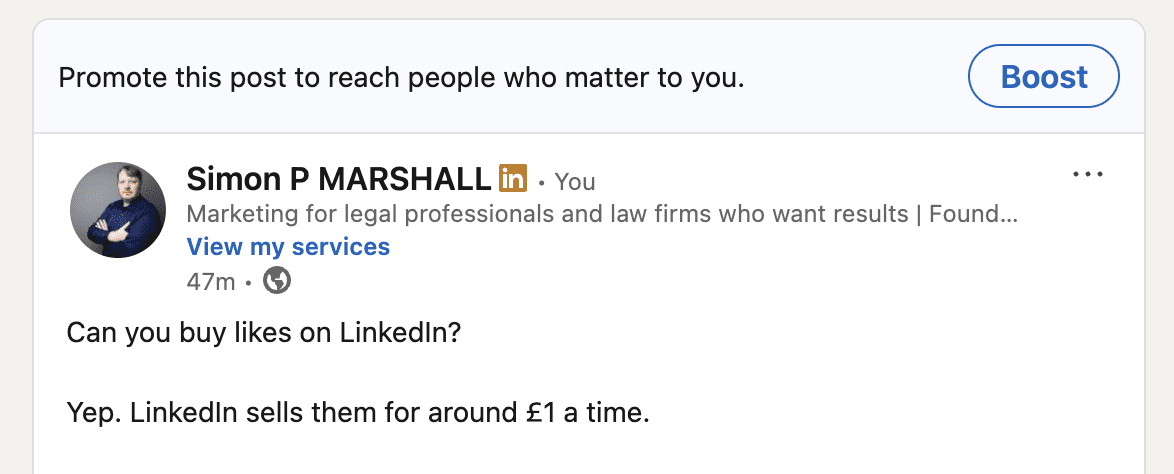Marketing budgets: the devil is in the detail
The Law Firm Marketing Club’s third annual Professional Services Marketing Survey has landed, and it makes for very interesting reading indeed. At 27 pages in length, it’s a chunky and important piece of research, chock-full of statistics and analysis.
The report’s findings are especially salient for firms with smaller marketing teams, as the vast majority of the survey’s data is drawn from more modestly-sized legal practices – it is always useful to know what firms of a similar scale to your own are spending on their marketing, how big their marketing teams are, the degree to which they outsource their marketing work, how they fared in 2022, and so on.
I commend Clare Fanner and her team for the report, which improves with each year’s edition, and encourage everyone in my network to take part in future surveys. That being said, I do see some room for improvement for the future editions, and feel that the current report’s findings need to be approached with a slight degree of caution, in particular the headline finding that law firms have increased their marketing budget by 0.3% to 2.9% of total revenue this year.
There are several reasons that make me hesitate to fully endorse these findings. One is that the report doesn’t contain sufficient granular detail on how this spend is broken down – specifically, the figures don’t include salaries, which is information that would greatly enhance our understanding of the make-up of the respective marketing department. Without this data, a like-for-like comparison isn’t really possible.
Secondly, when reading the report, it quickly becomes clear that the researchers haven’t had many responses from any of the top 100 firms – this becomes obvious from the report’s own figures, as it states that the average size of law-firm marketing teams is 3.1 people, and that the survey comprises 114 responses: ergo, no more than 353 individual law-firm marketers can be represented in the report, a figure that is equivalent to, say, five times the number of people in Osborne Clarke’s marketing team or similar to the size of DLA Piper’s marketing team. In other words, if this survey included top 100 firms, the figures for marketing team-size would be skewed massively. It is therefore not representative of what is happening within the industry’s big beasts.
Thirdly, the 2.9% figure for marketing budget is difficult for firms to benchmark against because it isn’t clear which activities are included: do business development, pay-per-click, email marketing, etc. all fall under this category? The answer will vary depending on the firm – that is to say that different systems for driving business will be allocated to different internal pots within the firms, and so we again cannot conduct a like-for-like comparison.
I hope my words are seen for what they are: constructive criticism on a project that I see huge value in. And I absolutely don’t mean to denigrate the current report’s overall usefulness for smaller firms outside the top 100. But I do think that, with some tweaks and a wider base of respondents, the report could be taken from good to great.
It’s well worth a read so please do download your copy of the Law Firm Marketing Club’s third annual Professional Services Marketing Survey here.
AI set to revolutionise the courtroom
Talk of the ongoing AI revolution is everywhere at the moment, with most of it centring around Open AI’s chatbot wunderkind, ChatGPT. The legal profession has been busy either trialling these AI-assisted tools, such as Allen & Overy’s Harvey, or throwing up roadblocks to their use due to concerns that doing otherwise might open a huge can of legal worms.
The latest voice to be heard in the ongoing debate over the use of AI in the legal sector is that of Sir Geoffrey Vos, Master of the Rolls. In comments made while delivering his McNair Lecture at Lincoln’s Inn last week, Sir Geoffrey stated that AI is set to revolutionise the way that lawyers and judges work, including in the courtroom – Vos predicts that, in future, it will even be used to make judicial decisions, albeit “at first, very minor” ones.
He commented on the lightning-fast iterative development of ChatGPT, referencing the fact that, whereas Version 3 scored in the bottom 10% when it took the American Bar Exam, Version 4 sat in the top 10% after completing the same exam: “This demonstrates the speed at which generative AI is developing. It perhaps makes the point that there is a real possibility that AI may become more intelligent and capable than humans. It is obvious that these advances will affect the legal world as much as any other part of our society.”
Considering how AI might positively impact cases in arbitration and in the Business and Property Courts, Sir Geoffrey noted that the “central element of any dispute resolution process is to identify the issue or issues that divide the parties. That issue, even in a complex case, can often, once identified, be simple. The difficulty is getting to it quickly and early enough to avoid massive cost. […] It is here that generative AI may be able to help. It may be that the power of AI could identify, from a mass of complex facts and transactions, the real issues that divide the parties and that require resolution”. In other words, AI might be able to cut to the heart of the matter much quicker than any lawyer, and provide a ruling that is shorn of any subjective bias.
Sir Geoffrey’s lecture struck an optimistic tone, with his overarching argument being that London and the UK could retain their preeminent status as a centre for dispute resolution if they embrace the possibilities of this new technology: “ […] if the UK’s judges and lawyers grasp the opportunities and face the challenges, the UK can become or remain one of the most attractive dispute resolution centres in the world”.
However, others are not quite so sanguine about the rapid rise of AI. As reported in Bloomberg Law, UK lawmakers are concerned about the threat that AI chatbots pose to workers’ jobs, and are urging regulators to take action to mitigate against “significant risks”. Parliament’s cross-party Business, Energy and Industrial Strategy Committee wants the Government’s newly announced, £100m generative AI taskforce to take into account potential updates to the current legislation in order to safeguard the UK workforce against the inevitable upheaval this disruptive technology will create.
The response to ChatGPT and AI in general presents such a mixed picture of trepidation and optimism. But whether you applaud it or fear it, one thing is for sure: AI is a genie that ain’t going back into the lantern any time soon.
The times they are a-changin’
Here at Si’s Matters, we have run many stories on the war against toxic workplace cultures recently. And it’s never been a more relevant issue: this year alone, Dominic Raab has been forced to resign after an independent investigation concluded that he had bullied civil servants; the CBI has seen its reputation almost completely destroyed in the wake of allegations of sexual misconduct and rape; and the Met has (yet again) been the subject of intense criticism following the publication of the Casey Report, which ruled that the force is (still) institutionally racist and homophobic.
It seems to be an almost inevitable part of the Zeitgeist that every major social issue is thrown into the hungry, gaping maw of the culture wars. And so it goes with the topic of workplace culture, with some sections of society seeking to frame the rise in complaints against bullying as just another iteration of what they see as the ‘snowflakery’ of entitled millennials. I am therefore heartened to see employment lawyers come out strongly against this ‘anti-woke’ worldview and put workplace bullies firmly on notice.
Speaking to the i newspaper last week, Max Winthrop, a partner at employment-law specialists Sintons Law, said that the rise in complaints against workplace bullying was not the product of whingeing young people, but instead the result of a shift in attitude amongst employees of all ages, from their twenties to their sixties as to what constitutes acceptable behaviour in the workplace.
His comments were supported by Anthony Purvis, head of employment law at Waterfront Law, who stated that there has been a sea-change in our culture that has rendered unacceptable behaviour that people would have felt forced to tolerate a generation earlier:
“A generation ago we might have said there was more of a stiff upper lip attitude towards conduct in the workplace or unacceptable conduct in the workplace – and I don’t see that much anymore. Each situation is taken on its facts and its circumstances, and if someone feels bullied and harassed we would expect them to say so.”
He added that the #MeToo movement and other major exposés of sexual harassment and workplace harassment have helped give people the confidence to speak out against inappropriate and unfair behaviour in the workplace.
The bottom line is that more and more people of all ages are simply unwilling to continue suffering in silence when it comes to being treated with contempt in the workplace. Long may this trend of outing horrible bosses continue – there are few things I abhor more than a bully, and I’ve encountered enough of them in my time.
More grounds for optimism
In last week’s edition, we wrote about the darling buds of an economic recovery. In the past week, there has been further cause for optimism with the news that UK consumer confidence is bouncing back, having now risen to its highest level since the outbreak of war in Ukraine in February 2022.
Research group GfK’s consumer confidence index plummeted to record lows last year when Russia invaded Ukraine, which sent energy prices soaring and helped fuel the rapid rise in the cost of living amid rampant inflation. Now, however, the mood amongst British consumers seems to be recovering rapidly, with GfK’s index showing a third consecutive month of increasing confidence levels.
Granted, the index is still well below zero, an indication that there is still wide-spread concern over personal finances and the wider economic outlook. But the general fog of gloom does seem to be lifting, as also indicated by the S&P Global / CIPS Flash UK PMI Composite Output Index (what a mouthful!), a tracker of private-sector activity whose findings map onto those of GfK: three consecutive months of an upward trend in economic activity, with the headline news that the index has risen at its fastest rate in a year.
Speaking to the FT, S&P Global’s chief business economist Chris Williamson comments: “The key takeaway is that the economy as a whole is not only showing encouraging resilience but has gained growth momentum heading into the second quarter.” He also notes that the growth is lopsided, “with surging demand for services contrasting with an ongoing downturn in demand for goods”.
A surging demand for services? Sounds like more good news for the legal sector, even amidst what continues to be a very mixed economic picture overall.
Cardiff solicitor runs the London Marathon a year after beginning chemotherapy
A good-news story that caught my eye this week is that of Cardiff-based solicitor Lucy Strong, who completed this year’s London marathon just four months after being told she was in complete remission from blood cancer, and just a year after beginning chemotherapy.
Lucy, a specialist asbestos solicitor and partner at top-100 firm Hugh James, was diagnosed with Stage II Hodgkin Lymphoma in early 2022, and underwent four months of chemotherapy treatment followed by three weeks of radiotherapy. The treatment was a complete success and Lucy was given the all-clear in December last year.
Exactly four months on, she ran the London Marathon and raised over £9,000 for Lymphoma Action, a charity that has provided her with crucial support during her illness and treatment. It’s a remarkable feat of resilience in the face of what I can only imagine to be a vastly frightening experience. Awesome and inspiring job, Lucy!
The ForThe100 campaign shortlisted for the Sheila McKechnie Foundation award
The Legally Safer Universities campaign spearheaded by ForThe100 with the assistance of TBD has been shortlisted for the Sheila McKechnie Foundation award in the Best Use of Law category.
Created in tribute to trade unionist and former director of Shelter, Dame Sheila McKenchie, the foundation set up in her name honours individuals or campaign groups that take on big organisations and challenge vested power. The Best Use of Law category celebrates “a campaign that has successfully used the law to drive change – whether using existing legislation to leverage rights and protections, or using strategic litigation to strengthen existing or create new legislation”.
It’s definitely been a team effort, but I really need to take my hat off to TBD’s PR and Content Lead, Sophie Flint. She had done an absolutely smashing job on this campaign and been instrumental in driving it successfully forward. You’ll almost certainly have seen her work on the news this week (BBC, ITV, Channel 5…) Thanks for all your heart work, Sophie!
As always, I hope you enjoy this week’s edition and welcome your comments and feedback.
Thanks,
Si Marshall






